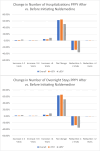Naldemedine Use and Healthcare Resource Utilization in Patients treated with Opioid Analgesics for Chronic Non-Cancer Pain: Results of a Real-world Study in the USA
- PMID: 40072725
- PMCID: PMC12085462
- DOI: 10.1007/s40122-025-00720-y
Naldemedine Use and Healthcare Resource Utilization in Patients treated with Opioid Analgesics for Chronic Non-Cancer Pain: Results of a Real-world Study in the USA
Abstract
Introduction: Opioid-induced constipation (OIC) is a common side effect of chronic opioid therapy that significantly impacts quality of life and healthcare costs. Naldemedine, a peripherally acting mu-opioid receptor antagonist, has shown efficacy in treating OIC. However, real-world evidence on naldemedine use in the United States is limited, particularly in older adults. We aimed to describe naldemedine use in real-world settings in the US, focusing on clinical characteristics, comorbidity profiles, co-prescribed medications, and healthcare resource utilization (HCRU), with a specific emphasis on older adults.
Methods: This retrospective study analyzed data from the 2017-2022 Merative™ MarketScan® Commercial and Medicare Databases. We identified 2110 naldemedine users aged ≥ 30 years on chronic opioid therapy. Demographic and clinical characteristics, co-prescribed medications, and HCRU were evaluated. Subgroup analysis focused on patients aged ≥ 65 years.
Results: The study cohort (66% women, median age 56 years, 14% aged ≥ 65 years) presented a significant comorbidity burden, with 57% having hypertension, 36% diabetes, and 25% chronic pulmonary disease with a Charlson Comorbidity Index ≥ 2 in 38% of subjects. Polypharmacy (i.e., use of five or more distinct drugs, excluding naldemedine) was very common (76%, 82% in ≥ 65 years). The most frequent indications for naldemedine were chronic back pain and radiculopathy. Oxycodone, hydrocodone, and morphine were the most commonly prescribed opioids. After initiating naldemedine, 30% of patients showed a reduction in hospitalizations per patient per year, with a more pronounced effect in older adults (37%). Potential drug-drug interactions with CYP3A4 inducers or inhibitors were infrequent and did not appear to impact HCRU.
Conclusions: This real-world study demonstrates that naldemedine is predominantly used in middle-aged adults with comorbidities and polypharmacy. Naldemedine use was associated with reduced HCRU, particularly in older adults, suggesting potential benefits in managing OIC. The findings support the safety and effectiveness of naldemedine in real-world settings, including in older patients with multiple comorbidities.
Keywords: Naldemedine; Opioid-induced constipation; Real-world.
© 2025. The Author(s).
Conflict of interest statement
Declarations. Conflict of Interest: Antonio De Vincentis and Raffaele Antonelli Incalzi have no conflicts of interest to declare with the present study. Bin Cai, Marco Moscarda, and Peter Barnes are employees of Shionogi at the time of writing. Ethical Approval: This study is conducted only using an existing anonymous, commercially available secondary healthcare claims database that meets the US Health Insurance Portability and Accountability Act (HIPAA) requirement. Therefore, the data do not meet the definition of human subject research.
Figures
References
-
- Dahlhamer JM, Connor EM, Bose J, Lucas JL, Zelaya CE. Prescription opioid use among adults with chronic pain: United States. Natl Health Stat Report. 2019;2021:1–9. - PubMed
-
- Opioids [Internet]. 2023 [cited 2024 Apr 26]. Available from: https://www.hopkinsmedicine.org/health/treatment-tests-and-therapies/opi....
-
- Candrilli SD, Davis KL, Iyer S. Impact of constipation on opioid use patterns, health care resource utilization, and costs in cancer patients on opioid therapy. J Pain Palliat Care Pharmacother. 2009;23:231–41. - PubMed
-
- Bell T, Annunziata K, Leslie JB. Opioid-induced constipation negatively impacts pain management, productivity, and health-related quality of life: findings from the National Health and Wellness Survey. J Opioid Manag. 2009;5:137–44. - PubMed
LinkOut - more resources
Full Text Sources
Research Materials


